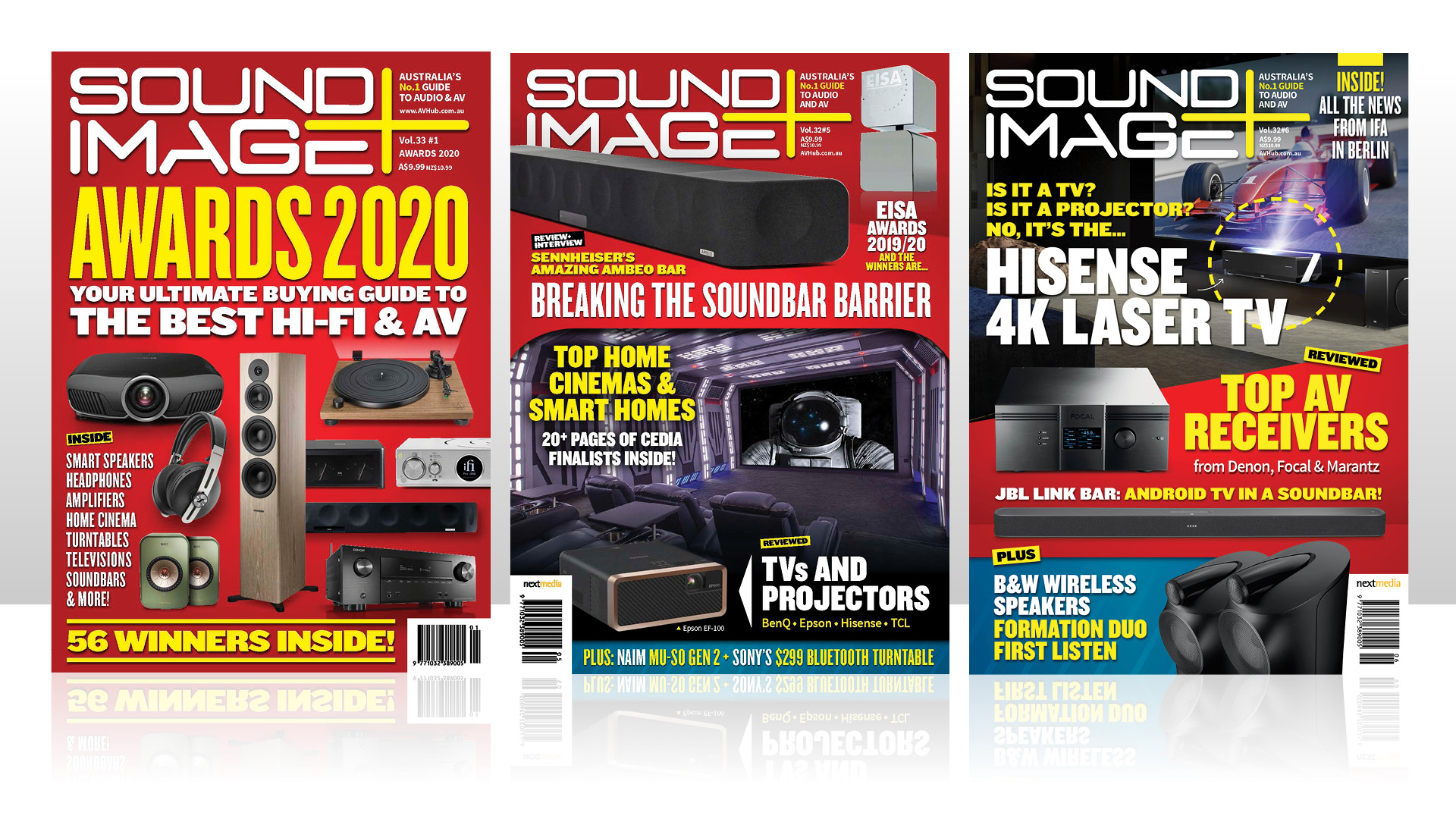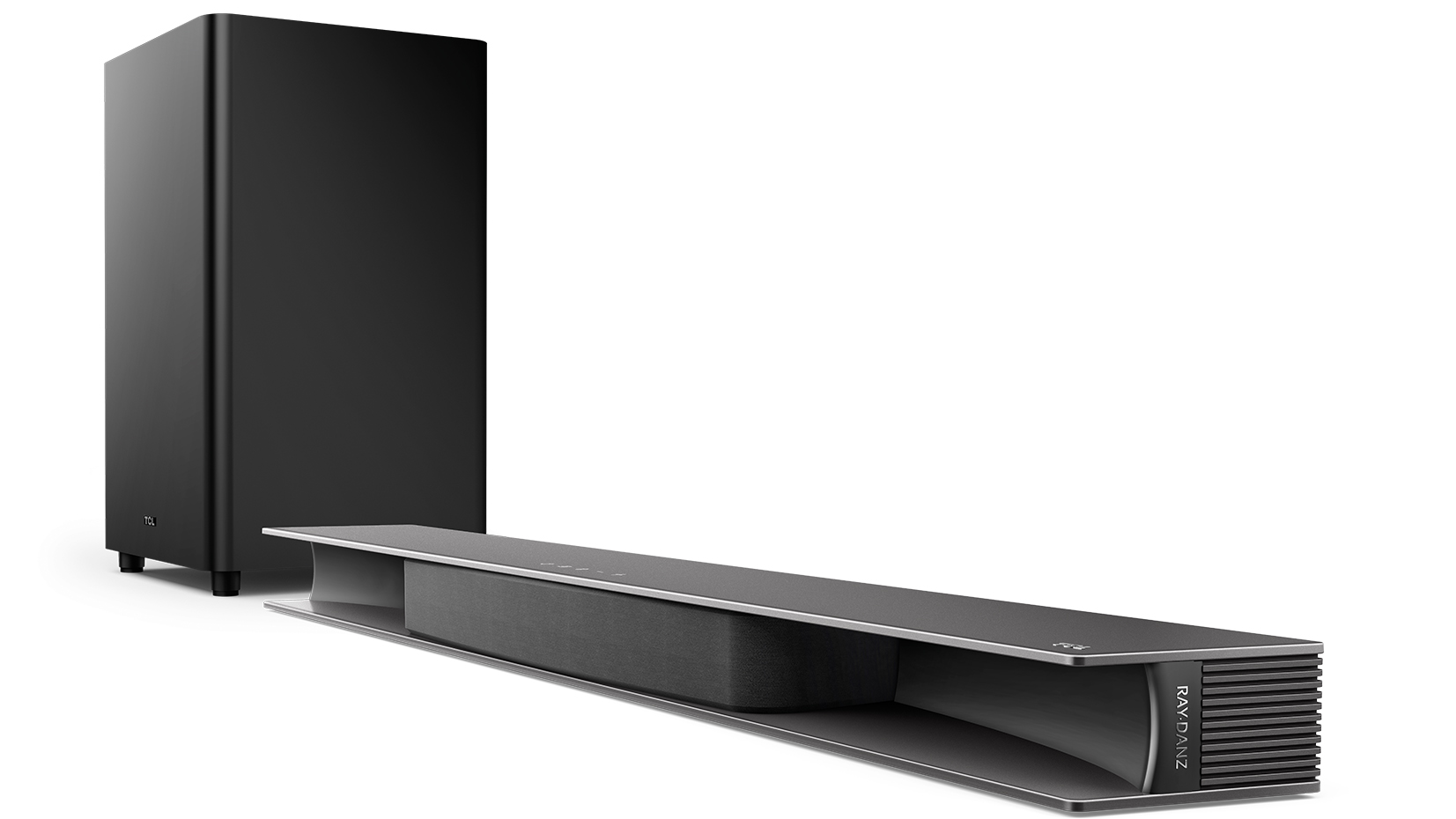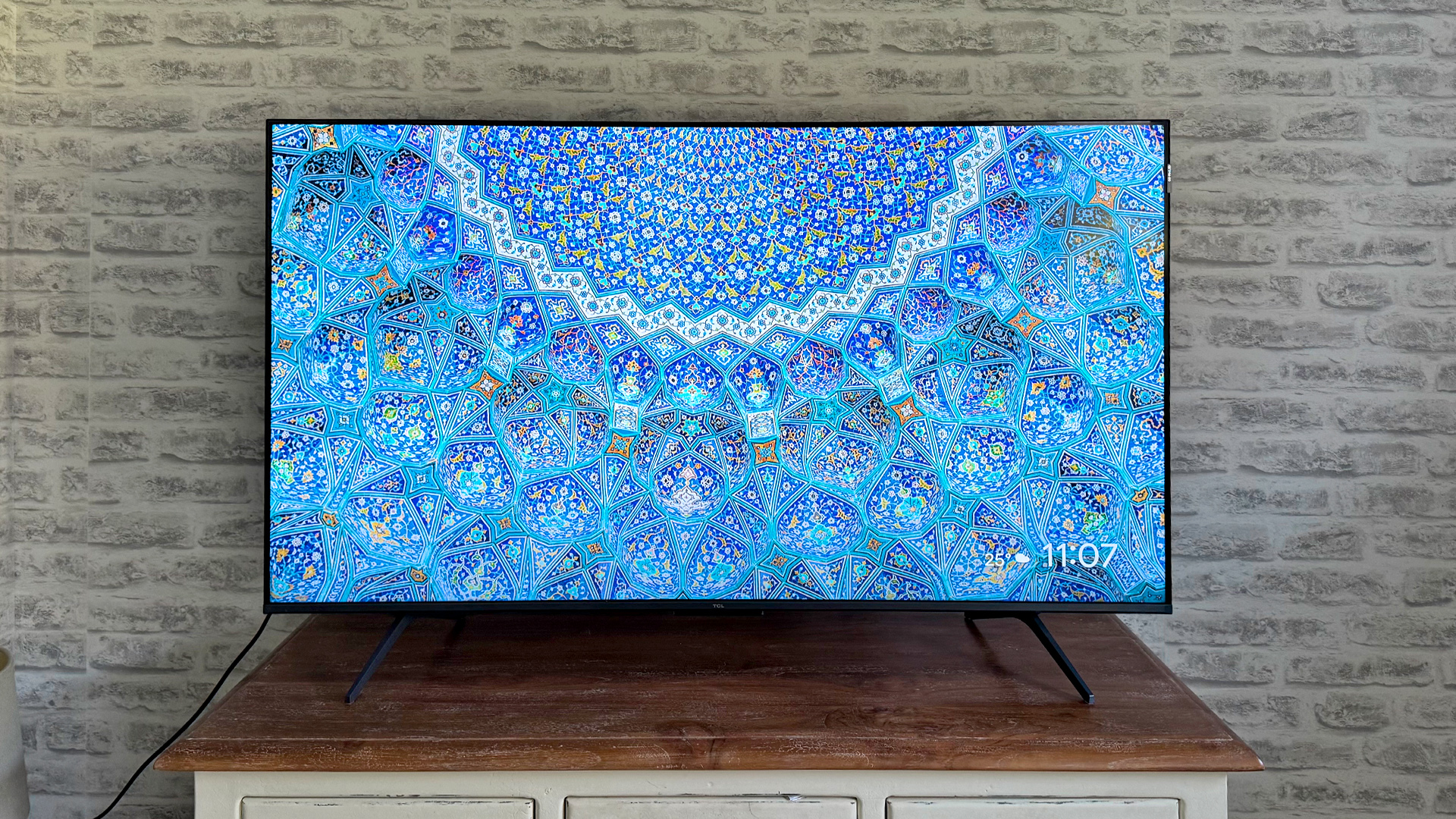Sound+Image Verdict
The Ray Danz TS9030 from TCL offers solid musicality, a unique front waveguide design, and great connectivity, and while it may not lead the pack in its price range, it's still a great performer.
Pros
- +
Built-in Chromecast & AirPlay
- +
Enjoyable for music
- +
Powerful Atmos delivery
Cons
- -
Variable TV/movie sound
- -
Audio processing lag
Why you can trust What Hi-Fi?

This review originally appeared in Sound+Image magazine, one of What Hi-Fi?’s Australian sister publications. Click here for more information on Sound+Image, including digital editions and details on how you can subscribe.
Three things we like in a soundbar: first the ability to deliver great TV and movie sound; second the ability to play music at least pleasingly; and third, the neatness for which the breed was originally created, at least when compared with a set of multichannel speakers around your lounge. One thing we really don’t like: soundbars which pretend to deliver multi-channel ‘surround’ sound without even having dedicated drivers to deliver each channel.
So it was pleasing that the packaging and manual of the TCL Ray Danz TS9030 doesn’t overly boast of impossible sonic feats. It uses the word immersive, and it advertises Dolby Atmos. But otherwise what it promises is clear dialogue, “ground-shaking bass”, a larger sweet spot – and these are the real merits of a well-priced soundbar. It’s a 3.1-channel Atmos bar, TCL says clearly, and accurately.
Yet it’s not without additional surprises – notably that it’s very friendly for audio streaming, with Wi-Fi connectivity enabling the Google Chromecast inside (so also compatibility with Google Assistant devices), plus Apple AirPlay. And there’s Bluetooth.
Equipment
Truth be told, we had expected something unusual, the Ray Danz coming to us after it had already won EISA’s 2020-2021 soundbar award for its performance. So while we (as EISA members) hadn’t then voted for it, enough of our global EISA colleagues did to place it at the top of the pack for its price.
And the price in Australia is nicely competitive with other markets – compare £348.17 in the UK or €380 in Germany to $799 in Australia, slightly more at RRP, though we’ve seen it on offer here at exact parity. That’s good to note – though it puts it in a competitive sector, up against models from other manufacturers known for their TVs: Samsung, LG and Sony.
Compared with the best of those, the TS9030 feels a lightweight when you draw the bar from its packaging. The reason is obvious as soon as you remove the wrapping – more than half of its frontage is missing, scooped away for two extended waveguides; this is the ‘Ray Danz’ technology referenced in the product name. So only in the centre of the bar does a fabric-covered section protrude flush to the bar’s front, housing forward-facing drivers.
The scoops of the waveguides are solid shiny black plastic: indeed most of the construction is plastic, sensibly matte on the top surface, and slotted (but solid) on the sides and rear, where a cover keeps the input sockets hidden and provides cable management from gaps it creates when slotted back into place. It’s not immediately obvious how to remove this cover – you have to turn the bar over before it slides off easily. This bar is wall-mountable, with a kit included in the box.
The latest hi-fi, home cinema and tech news, reviews, buying advice and deals, direct to your inbox.
TCL generously includes both an optical and an HDMI cable in the box, though we substituted a shiny new Austere-branded HDMI cable (pictured below right) to make the all-important connection between the HDMI ARC sockets of soundbar and TV. There’s also an HDMI 2.0 input on the bar for an external device, which will be the best way to pass the bar any Dolby Atmos soundtracks, which it supports.
In the bays at the rear are those two HDMI sockets, plus the usual fallback soundbar inputs of optical and minijack analogue inputs for when HDMI ARC won’t work. There’s also a USB-A slot to play music from a stick or drive; the manual says it plays only MP3, WAV and FLAC files, though once we’d managed to get our USB stick into the limited space around the slot (small sticks or an extender cable recommended!) we found it also handled WMA files. WAV and FLAC were limited to CD quality; high-res files were skipped. The final inputs are wireless stereo – the aforementioned Chromecast and AirPlay streaming over Wi-Fi, plus Bluetooth.
So as noted, this is a 3.1-channel bar, with a dedicated centre channel between the left and right, all the better to support dialogue clearly. But with that reduced front area and grilles dense enough to prevent us peeking beneath, we were a bit baffled as to identifying the driver positions, until locating the ‘exploded’ diagram included overleaf. The front section houses two centre drivers (a tweeter and oval midrange generously quoted at 44 × 74mm).
Then the left and right oval drivers face sideways on the edges of the centre section, so they fire straight down those waveguides which purport to shoot the sound out sideways and possibly, room layout permitting, bouncing their sound from side walls. This won’t create surround – there’s no dedicated driver to deliver rear information. But it certainly promises an ability to create a wide stereo sound, supported by the additional centre drivers.

No upwards drivers? How, then, can it claim Dolby Atmos, which brought height channels to the worlds of cinema and home cinema? As we regularly note, supporting Dolby Atmos doesn’t necessarily mean delivering height information. It means the unit accepts a Dolby Atmos signal and can translate its object-based data and conventional beds for whatever sound system is attached – here a 3.1-channel soundbar.
TCL’s literature does not mention or claim height, and good on them. We’ve seen too many false claims for soundbars past and present, so that TCL’s more honest approach is refreshing. However, the remote control does have one button labelled ‘Vertical Surround’ – interestingly the same name used by Sony in its soundbars.
The bar supports Dolby Digital, Digital Plus, TrueHD and Atmos soundtracks – however, to get Atmos to the bar, you may (we did) have to plug something into that HDMI input, since many TVs won’t deliver Dolby TrueHD-based Atmos through HDMI ARC. That also, in theory, limits playback from smart TVs loaded with apps delivering Atmos, such as Netflix and Disney+; your TV is likely to drop the soundtrack to stereo or at best Dolby Digital before passing it to the TCL soundbar. Does this matter when the bar’s drivers are only delivering three channels anyway? Let’s see.
Performance
We plugged our TV in via ARC and later optical, and added first an Oppo Blu-ray player, later an AppleTV 4K into its HDMI input. The hardest connection to plug in is the mains cable, which lacks sufficient finger room to push it home fully.
The Ray Danz immediately endeared itself with user-friendliness, flashing ‘HELLO’ from large LED segments behind the front grille. This display may look slightly blocky and old-school, but we ain’t criticising, having recently suffered a number of soundbars which have their only indicators on the top of the bar, where you can’t see them. (Duh.) We’ll take TCL’s exuberant but visible display over that any day.
The remote control is also well-stocked and intuitive: volume in the middle, flanked by separate bass and treble controls – no need to dive into menus to tweak the tone. Ditto separate and well-labelled inputs, a button to shuttle through sound modes, and most unusually an AV sync control. Finally that ‘Vertical Surround’ button, its selection hampered only by the display being limited to showing ‘Sur O’ until it scrolls, which could be either Sur On or Sur Off. You can, however, instantly tell by the sound.
But we started off in simple ‘Music’ mode, where music was handled impressively well. We got it networked by using the Google Home app (because it has Chromecast inside), then spent a great deal of time casually playing to it from an iPad Pro via AirPlay, to which it always instantly switched, seemingly defaulting to the ‘Music’ sound mode and, while no match for a decent pair of stereo speakers, managing a perfectly enjoyable and tonally balanced musical delivery which could, at our whim, be turned up impressively loud without distress to either the drivers or our ears, something most unusual in a soundbar at this price.
The Strypes’ Mystery Man belted out, solid and powerful as it should be, yet there was also enough subtlety to handle the busy mix of Santana’s Oye Como Va, and to allow access to the subtleties of The Waifs’ Beautiful You, on which the bass line was nicely full and maintained that way to its lowest notes thanks to a well-integrated subwoofer – indeed we used the tone controls to take a notch off the bass for our preferred balance.
Things were sometimes a little artificial, and especially so off-axis where those side-firing drivers could emphasise the treble: listening from off to one side, Dylan’s vocal on Desolation Row became increasingly pinched as we moved away from the (admittedly wide) centre sweet spot.
We found that Chromecasting sometimes emerged at very reduced quality (thin and edgy, sounding low-res), this glitch hard to pin down to source (iPad Pro and its apps) or sink (the TS9030), other than noting we’ve never had this dichotomous behaviour before. But usually (after reconnecting) it was the equal sister to the AirPlay connection.
Once we’d made the soundbar part of our Google Home, we could use a nearby Google Home device to do stuff – saying “Hey Google play music to the Ray Danz” (as we’d named it) would send Spotify flowing through with the shortest of delays. Any choice of the different music or surround modes seemed to be locked off during such casting.

Bluetooth connected quickly after holding the Bluetooth button down on the bar to begin the pairing process – this confirmed by the large-letter display on the front of the bar, and by a ‘Steve Austin’ pinging sound as it made itself available. Via Bluetooth the sound was notably softer in the treble and a little lumpier in the bass, taking a little beauty out of the Waifs track, in particular, compared with the higher-resolution AirPlay streaming option, but still enjoyable.
With TV and movie fare via HDMI or optical we had a harder job picking our preferred sound mode. ‘Movie’ mode slightly took the edge off dialogue intelligibility. ‘Music’ mode shrank the sound and added a little distance to dialogue, as did ‘TV’. ‘Boost’ sounded quite full but a little phasey.
Most unusually we preferred the Vertical Surround to be ‘on’ when in movie mode. Our main criticism, on all modes, was that it introduced sufficient audio delay that we had trouble watching anything. That AV Sync button could only add further audio delay, not the video delay which would be required to fix this.
Our Oppo Blu-ray player is capable of delaying video in this way, and of delivering Atmos, but when we plugged that player direct to the HDMI input there was a mysterious HDMI issue, with everything pink and no audio, like a loose plug but unfixable by changing cables and checking connections; it was unresolved.
Instead we plugged in an AppleTV 4K to its HDMI input, loaded up the Atmos soundtrack of Pixar’s Upward – and all was transformed. The words Dolby Atmos rippled along the display. The lipsync audio lag was reduced to acceptability; dialogue was solid, crisp and clear. Effects were thrown wide beyond the confines of the bar – far beyond; this was very impressive.
After the final fight of Upward, the Mother’s second shout of “Ian” came very nearly from behind us, far out to the left. Bass was rumbling along in all the right places. And as with music you could seriously crank it. Here at last we enjoyed the quality we had expected after the recommendation of our EISA colleagues. But we must say that it had taken some while to get there, and it didn’t work for all our circumstances.
Verdict
For these reasons we wouldn’t place the TS9030 ahead of our very favourite soundbars at the price, notably Samsung’s Q800T, which recently won Sound+Image's Soundbar of the Year award in this price bracket. But the TCL is well forward of the pack, in many ways an impressive and different tilt at the soundbar market, with the wide delivery of those Ray Danz waveguides, and that combo of Chromecast, AirPlay and inherent musicality making it especially friendly for music playback.
Sound+Image is Australia's no.1 mag for audio & AV – sister magazine to Australian Hi-Fi and to the UK's What Hi-Fi?, and bestower of the annual Sound+Image Awards, which since 1989 have recognised the year's best hi-fi and home cinema products and installations. While Sound+Image lives here online as part of our group, our true nature is best revealed in the print magazines and digital issues, which curate unique collections of content each issue under the Editorship of Jez Ford, in a celebration of the joys that real hi-fi and high-quality AV can bring. Enjoy essential reviews of the most exciting new gear, features on Australia's best home cinemas, advice on how to find your sound, and our full Buying Guide based on all our current and past award-winners, all wrapped up with the latest news and editorial ponderings. Click here for more information about Sound+Image, including links to buy individual digital editions and details on how best to subscribe.


